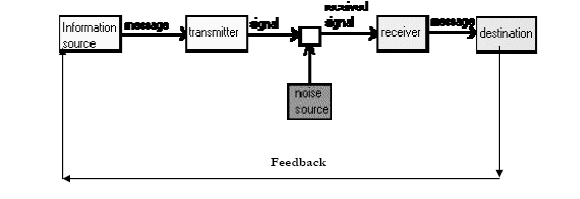Feed back
In its simplest form the feedback principle means that a behavior is tested with reference to its result and success or failure of this result influences the future behavior
Though not exactly cut-out for human communication, the Shannon-Weaver model provides clear guidelines for researchers to mark more avenues for graphic presentation of the elements in daily human communication.
Forms of feed back
There are five main categories of feedback. They are listed in the order in which they occur most frequently in daily conversations.
1. Evaluation
Making a judgment about the worth, goodness, or appropriateness of the sender’s statement.
2. Interpretation
Paraphrasing – attempting to explain what the sender’s statement means.
3. Support
Attempting to assist or support the sender.
4. Probing
Attempting to gain additional information, continue the discussion, or clarify a point.
5. Understanding
Attempting to discover completely what the sender means by his/her statement.
Role feed back plays in effective communication?
Feedback is a vital part of communication. In the class room students’ facial expression tell the teacher to go to what extent to make students understand the point under discussion. More or less, these expression would guide the teacher where and when to finish.
When we are talking to someone over the phone, if they don’t give us the occasional ‘mmmm’, ‘aaah’, ‘yes, I see’ and so on, it can be very disconcerting. In face-to-face communication, we get feedback in the visual channel as well – head nods, smiles, frowns, changes in posture and orientation, gaze and so on.
Why do people often have difficulty when using computers, when they find it perfectly easy to drive a car? You’d think it should be easier to operate a computer – after all there are only a few keys and a mouse, as against levers, pedals and a steering wheel. A computer’s not likely to kill you, either. It could be due to the lack of feedback in a car, you’ve the sound of the engine, the speed of the landscape rushing past, the force of gravity. Feedback is coming at you through sight, hearing and touch -overdo it and it might come through smell as well. With a computer, there’s very little of that. In fact you apply more of your brain as what you must be doing next rather than shaping your activity whether it’s being liked or not by the machine.
Sending and receiving of message is a simultaneous process in which the receiver continuously sends back its approval or disapproval after having interpreted the message. This helps the sender to modify or discipline its message. This element in the communication process is referred as feedback. For instance a person is delivering speech, the voices, gestures and facial expressions – all part of feedback, would help the speaker to check its loudness, smiles, rhetoric, contents or time to speak. If there is no feedback, the original message may never shape accordingly which may distort the whole communication exercise.
Included Feedback
Communication is reciprocal, two-way, even though the feedback may be delayed.
- Ø Some of these methods of communication are very direct, as when you talk in direct response to someone.
- Ø Others are only moderately direct; you might squirm when a speaker drones on and on, wrinkle your nose and scratch your head when a message is too abstract, or shift your body position when you think it’s your turn to talk.
- Still other kinds of feedback are completely indirect.
By “feedback” the speaker receives information about how his or her message has been received by the listeners and, in turn, responds to those cues. The feedback process is not complete until the speaker has responded to the listener. This process includes the listener’s reactions to the speaker’s response and so
By two-way communication or feedback
This feedback will tell the sender that the receiver understood the message, its level of importance, and what must be done with it. So the feedback loop is the final link in the communication process. Feedback is the check on how successful we have been, in transferring our messages as originally intended. It determines whether understanding has been achieved or not.
The purpose of feedback is to change and alter messages so the intention of the original communicator is understood by the second communicator. It includes verbal and nonverbal responses to another person’s message. forth.
